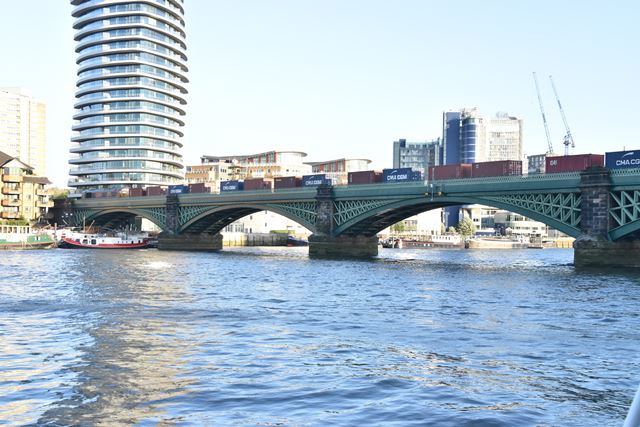Official Heritage Listing Information and Findings
Listed At: Grade II*
Discussion:
List Entry Number: 1393005
Reasons for
Designation
The Cremorne Bridge was opened in 1863 as part of the
West London Extension Railway and is designated at Grade II* for the
following principal reasons:
* It is extremely significant as a
bridge with arches constructed largely of wrought iron. * Its
completeness is of particular note which, together with its visually
attractive design, makes the bridge of more than special architectural
interest. * It is also of more than special historic interest as one of
the earliest Thames rail crossings and the most complete of the six new
rail bridges which were constructed in the 1860s. * Built to link four
well-established routes and the first north-south railway line in
London, it is a structure which epitomises this important phase of
railway history. * It also has group value with the Battersea Bridge of
1890 downstream (Grade II) and the Wandsworth Bridge of 1940 upstream
(recommended Grade II).
Railway Bridge, 1863, by William Baker,
Chief Engineer of the London and North Western Railway Company, and T H
Bertram of the Great Western Railway and opened on 2 March 1863. The
contractors were Brassey and Ogilvie. Minor later alterations and
repairs.
DESCRIPTION: The Cremorne Bridge is a five-span
wrought-iron arch bridge flanked by six brick arches on both the
Middlesex and Surrey shores. The five river spans are each 43.9m, and
the total length of the structure is 387.1m. The spans are carried on
riveted wrought-iron arched ribs arranged in pairs and joined by lattice
spandrel members to the deck girders, the whole forming a series of
light segmental arches. There are six ribs to each span, in three pairs,
with the inner ribs cross-braced under either track. The latter may have
had some replacing and strengthening in steel in the C20 but the upper
and lower chords and spandrel members of the arches are fabricated
wholly of wrought iron. The river piers are constructed of brick faced
with Bramley Fall stone ashlar on concrete foundations; these piers are
carried up in ashlar with roll-moulded cornices at parapet level. The
abutment piers of the river bridge are also ashlar. The parapets, which
are topped by wrought iron lattice railings, have recently been refaced
as part of a general programme of repairs.
HISTORY: The Cremorne
Bridge takes the form of a viaduct that carries both standard and the
broad gauge railway tracks needed for Great Western railway stock. The
opening of Cremorne Bridge led to an increase in freight traffic but
passenger services did not commence until 1904. The purpose of the
bridge was to connect the main northbound lines out of Paddington and
Euston with the southbound lines from Waterloo, Victoria and Clapham
Junction through the West London Extension Railway, an enterprise
jointly owned by the London and North Western Railway and the Great
Western Railway (one-third each), and the London and South Western
Railway and the London, Brighton and South Coast Railway (one-sixth
each). The West London Railway Extension was built to connect the GWR
with the Channel Ports via railways on the south side of the Thames such
as the South Eastern Railway.
This is one of the earliest
railway bridges to cross the Thames, and among the earliest surviving
examples. The initial phase of railway expansion in the 1840s and 1850s
had little impact on the Thames, in part because a parliamentary
prohibition on surface railways in central London. The ban was lifted in
1846 but by this time the distinctive ring of railway termini around
central London had been built and there was little financial incentive
for companies to link the north and south banks. The first railway
crossings were therefore built in outlying districts: the first, Barnes,
was complete by 1848 (listed Grade II) and Richmond followed not long
after. The fast pace of development south of the river after 1860 led to
six further bridges of which the Cremorne Bridge is one of the earliest
that survives in its original form; the bridge has been little altered
since 1863, although there have been repairs made following incidents of
vessels colliding with the bridge in the early 1990s and in 2003. Of the
other bridges, only the southern abutment to the former West Blackfriars
and St Paul's railway bridge is listed.
The name Cremorne (the
bridge is also known as Battersea Railway Bridge) refers to the former
Cremorne pleasure gardens which once occupied the site of the Lots Road
Power Station. The gardens closed in 1877.
REASONS FOR
DESIGNATION: * As a bridge with arches constructed largely of wrought
iron, the Cremorne Bridge is extremely significant; its completeness is
of particular note and for this, and its visually attractive design, the
bridge is of more than special architectural interest. * It is also of
more than special historic interest as one of the earliest Thames rail
crossings and the most complete of the six new rail bridges which were
constructed in the 1860s. * Built to link four well-established routes
and the first north-south railway line in London, it is a structure
which epitomises this important phase of railway history. * It also has
group value with the Battersea Bridge of 1890 downstream (Grade II) and
the Wandsworth Bridge of 1940 upstream.
SOURCES: G Phillips,
'Thames Crossings' (1981),190-1. A A Jackson, 'London Termini' (1969),
221 and 290. C Awdry, 'Encyclopaedia of British Railway Companies'
(1990), 242. E T Macdermot, 'History of the Great Western Railway',Vol I
(1964), 231-3. Jack Simmons and Gordon Biddle, eds, The Oxford Companion
to British Railway History (OUP, 1999).
|


![]()
![]()
![]()

